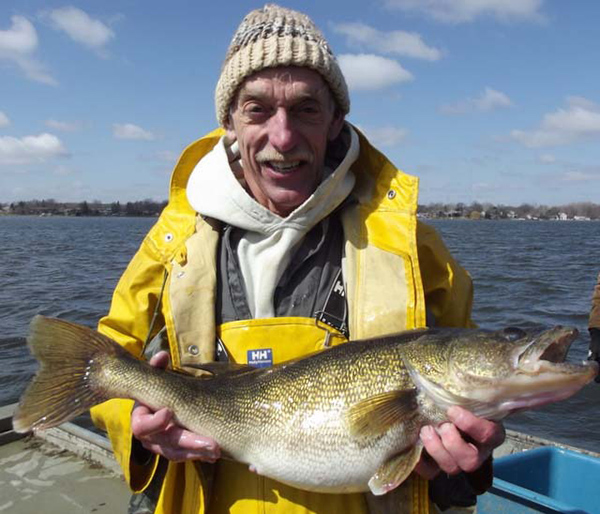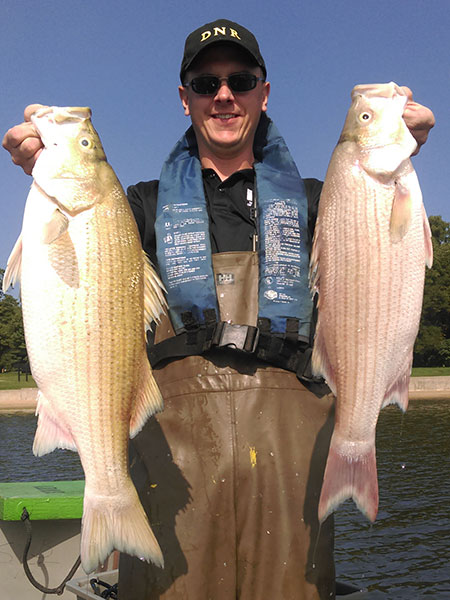- Details
By Louie Stout
 Retiring Indiana Biologist Jed Pearson Put Anglers First
Retiring Indiana Biologist Jed Pearson Put Anglers First
Indiana anglers lost a valuable ally last week when District Biologist Jed Pearson called it quits.
Pearson spent 49 years working for the Indiana DNR and 44 of those as a northern Indiana fisheries biologist.
The 68-year-old fish management veteran has been instrumental in several northern Indiana fish successes, none the least of which has been improved bass fisheries and the development of the successful muskie program in Kosciusko County.
However, of all of his accomplishments – of which there were many - he lists his participation in acquiring more than a dozen public access sites on northern Indiana waters as his proudest.
“I always felt that was a priority,” said Pearson. “It was frustrating that we never had the money to go buy land so I was out begging for donations. I never understood why Indiana could have money to build access sites, but couldn’t come up with the money to buy the land. In my eyes, providing public access was one of the most important things we could do as a fisheries agency. It is permanent and not something that is here today and gone tomorrow.”
- Details
By Louie Stout
 Potato Creek ‘Wipers’ Deserve More Attention from Michiana Anglers
Potato Creek ‘Wipers’ Deserve More Attention from Michiana Anglers
Unless you’ve had a rod ripped into the water while fishing off the bank or had something destroy your crappie rig, you may not know there’s a pretty cool – and big - fish swimming at Worster Lake.
The hybrid striped bass – also known as a wiper – has been stocked in the Potato Creek State Park for eight years but darn few anglers fish for them.
A few of the fish get caught, but usually by unsuspecting anglers targeting other fish. When you hook a big one, you’ll know it; they are aggressive biters, hard-pullers and make good table fare when grilled, broiled or baked.
- Details
By Louie Stout
By now you’ve probably heard about the fish kill at Diamond Lake that occurred earlier this month.
Based on best guess estimates, it affected about 1,000 fish of several different species.
It’s still under investigation by the Michigan DNR Fisheries and the Department of Environment and Great Lakes and Energy (EAGLE), formerly known as Department of Environmental Quality (DEQ).
Don’t expect much to come out of this investigation. Fisheries Biologist Matt Diana was at Diamond last week and said the fish he saw had already begun decomposing, too late for any analysis.
“We’ve been getting a lot of calls from people around the lake; as the winds shift dead fish move from one shore to the other,” he said. “It’s difficult to determine what killed them or how many, but I can say that it wasn’t a major kill and shouldn’t have a big impact on fish populations.”
Dead fish showed up two days after the lake had been treated with chemicals to kill non-native vegetation.
Diana wouldn’t single out the chemical application as the sole cause, but said it may have contributed to it.
- Details
By Louie Stout
I can’t help but notice a disturbing trend in boating accidents and drownings throughout Indiana this year.
I have seen some really unfortunate accidents in Indiana DNR Law Enforcement reports that could have been easily prevented with a little common sense.
“It seems like every spring we see an influx of drawings because everyone is eager to get on the water even though our waterway levels are elevated,” said Capt. Jet Quillen of the Indiana DNR. “People put themselves in dangerous situations by going onto flooded or high water. The current is faster and they lose control.”
This brings me to the point of this column: Kayaks - from which a number of people have died this spring.


